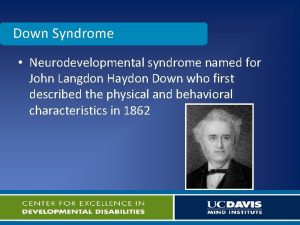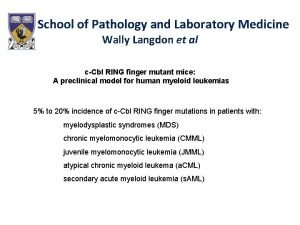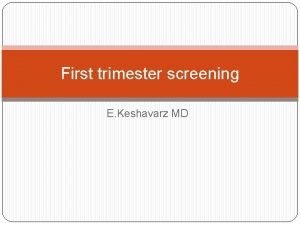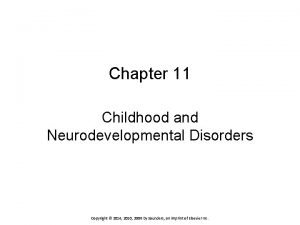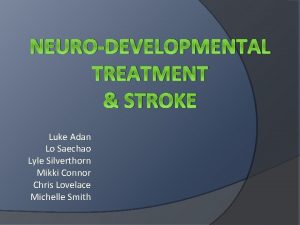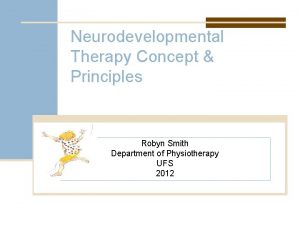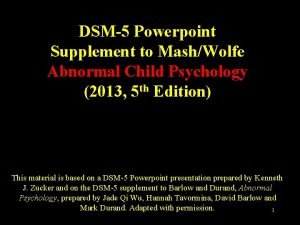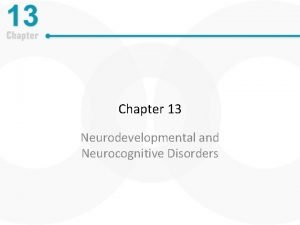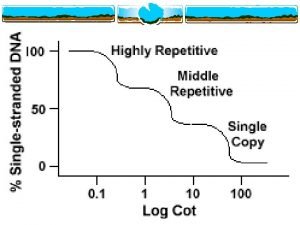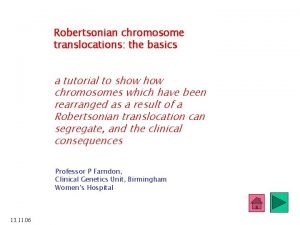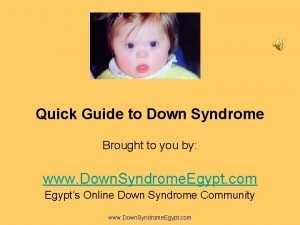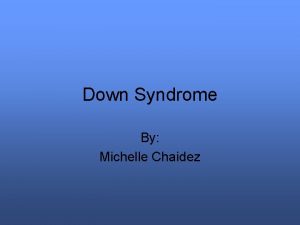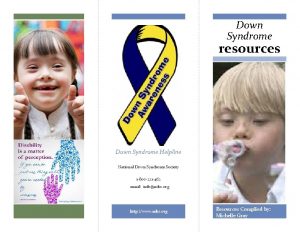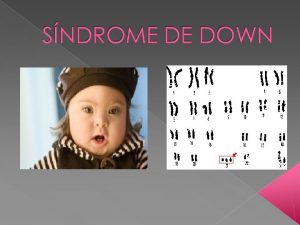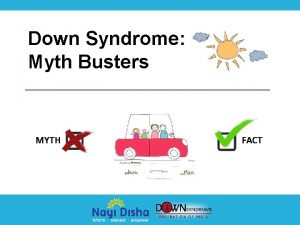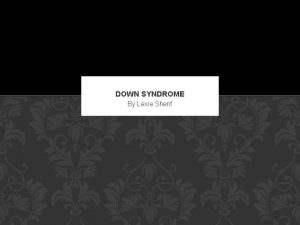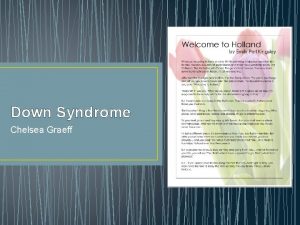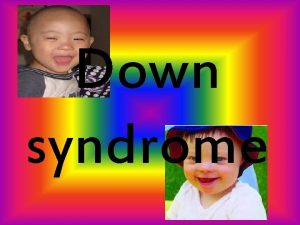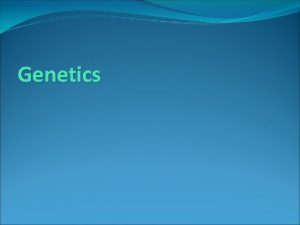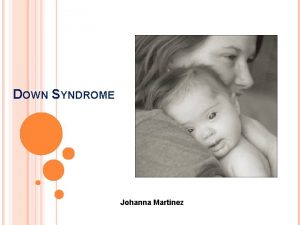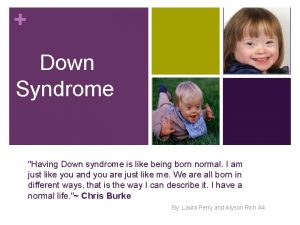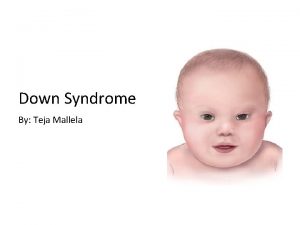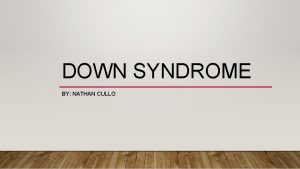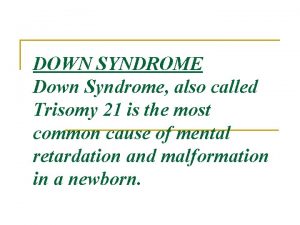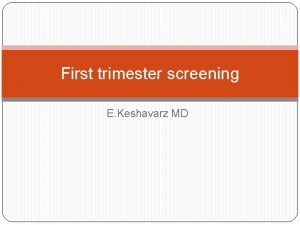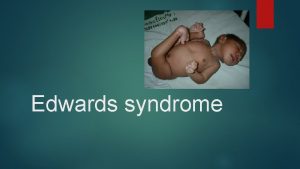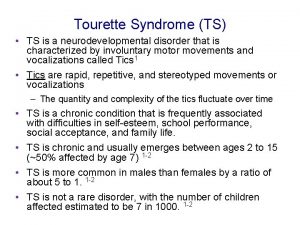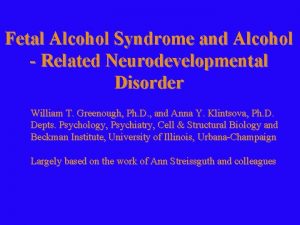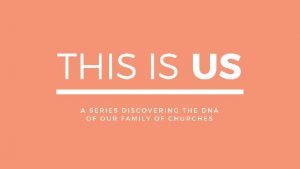Down Syndrome Neurodevelopmental syndrome named for John Langdon






















- Slides: 22

Down Syndrome • Neurodevelopmental syndrome named for John Langdon Haydon Down who first described the physical and behavioral characteristics in 1862

Down Syndrome • 1958 Jerome Lejeune and his team identified trisomy 21 (47 chromosomes-one extra chromosome 21 in cells) as cause of Down Syndrome – Only 2 years after it was discovered that the typical number of humanchromosomes was 46

Human Karyotype (picture of chromosomes that hold genes)

Meiosis Watch Video Here https: //www. youtube. com/watch? v=n. MEye. KQClq. I

Down Syndrome Typical cell division- 46 chromosomes Non-dysjunction cell division 47 chromosomes


Down Syndrome • 90 -95% full trisomy from nondysjunction of maternal origin during meiosis • 2 -4% translocation – (usually 13 -15 or 21 -22) • 2 -4% mosiacism – nondysjunction occurs after fertilization resulting in two different cell lines


Health in Down Syndrome • Heart: – 40 -60% born with abnormal hearts

Health in Down Syndrome • Eyes: cataracts and glaucoma – 5% Cataracts – 1% Glaucoma – Near-sightedness • Ears: hearing loss – 30 -75% by preschool

Health in Down Syndrome • Thyroid: low thyroid – 30% by 25 years • Gut: celiac disease (wheat allergy) – 4 -7% • Immune dysfunction: – autoimmune/leukemia

Down Syndrome • Brain: – Seizures 8%-50% by 50 years – Sleep apnea – Developmental delays/learning differences

Development in Down Syndrome • Social and self help skills usually on track early and often remain strengths • Motor skills (sitting, walking, running) delayed due to low muscle tone, joints • Language skills often start on time, but usually slow in second year and affect talking more than understanding

Early Communication Skills in DS 6. 10% 18. 60% Gestures (range: 7% - 46%) 23. 60% Vocalizations (range: 11% - 76%) Single Words (range: 6% - 53%) Multiple Words (range: 0%- 34%) 51. 70%

Down Syndrome • Academic/cognitive skills usually lower than adaptive/every day skills, which show improvement through mid-adulthood • Onset Alzheimer dementia (losing memory and skills) 10 years earlier than general population • Diabetes/obesity • Less cardiovascular disease • Lower blood pressure

Development in Down Syndrome • Social supports, cognitive skills, emotional and physical health predict adaptive function and employment

Down Syndrome • Kumin et al (2015) J of Applied Research in Intellectual Disability – 57% employed (3% full time) – 20% volunteered – 3% self-employed – 30% unemployed

Down Syndrome and other diagnoses Autism spectrum disorders thought to occur in 10% of people with Down Syndrome ADHD thought to occur in 6 -8% of people with Down Syndrome Other behavioral diagnoses in 10 -15%

Research at MIND: Vocabulary Kover et al. J Speech, Lang, Hear Res (2012)

Research at MIND: Language Syntax Kover et al. J Speech, Lang, Hear Res (2012)

EXPRESSIVE LANGUAGE SAMPLING CONSORTIUM SITES (n = 36 -60 per site)

Research in Down Syndrome • Alzheimer neuropathology – Acetylcholinesterase inhibitors? • Studies showing improvements in speech, communication, attention and mood stability with donepezil (Aricept) in open label study, less significant differences in DB/PC study on dementia and adaptive behaviors but still some improvements – NMDA receptor antagonists? • Studies with Memantine not clear re: benefit
 John langdon down
John langdon down Mark twain wife
Mark twain wife Fiona langdon
Fiona langdon Mark twain icon
Mark twain icon Rph pathology
Rph pathology Tony langdon the crown
Tony langdon the crown Tony langdon
Tony langdon Chapter 11 childhood and neurodevelopmental disorders
Chapter 11 childhood and neurodevelopmental disorders Reflex inhibiting patterns
Reflex inhibiting patterns Robyn smith therapist
Robyn smith therapist Dsm 5 vs dsm 4
Dsm 5 vs dsm 4 Major neurocognitive disorder criteria
Major neurocognitive disorder criteria Neurodevelopmental disorders
Neurodevelopmental disorders Sound of heaven touching earth
Sound of heaven touching earth Hands up utensils down
Hands up utensils down There's a place where mercy reigns
There's a place where mercy reigns Pressure pushing down on me
Pressure pushing down on me I fled him down the nights and down the days
I fled him down the nights and down the days Familial down syndrome
Familial down syndrome Afp mom
Afp mom Is pku autosomal or sexlinked
Is pku autosomal or sexlinked Unbalanced translocation down syndrome
Unbalanced translocation down syndrome Are there types of down syndrome
Are there types of down syndrome
